The 55th annual New York Antiquarian Book Fair takes place in New York City from April 9 to 12, 2015. Many ABAA member dealers will be exhibiting. Here are a selection of their featured items that will be available at the fair.
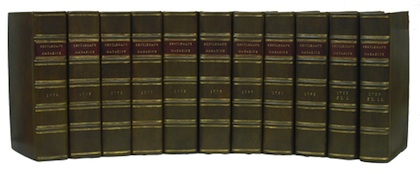
Urban, Sylvanus (ie. David, Henry), ed. THE GENTLEMAN'S MAGAZINE: AND HISTORICAL CHRONICLE. FOR THE YEAR MDCCLXXIV [1774] [THROUGH] MDCCLXXXIII [1783] [TEN VOLUMES IN ELEVEN]. London: Printed at St. John's Gate for D. Henry, 1774-1783. 120 issues plus 8 supplements as issued (no supplements issued in 1774 and 1783). Illus. with 164 engraved portraits, figures, maps, and plans (75 folding, 1 facsimile) plus numerous in text drawings. 8vo. Full modern brown calf, five raised bands, red morocco spine labels, gilt titles and rules, in period style. ($14,500)
Offered by Kaaterskill Books (Booth B6)
---
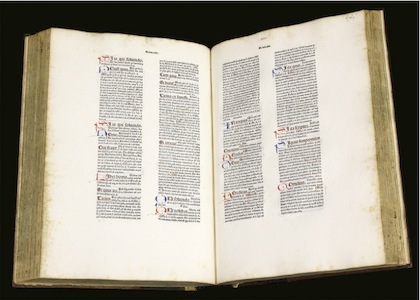
Bartolo of Sassoferrato [1314-1357].
[Super Prima Parte Infortiati]. [Venice, Nicholas Jenson, 28 March 1478]. Collation: a10, b-z8, A-C8, D-E6. 221 of 222 ff. Final leaf, a blank, lacking. Folio (16-1/2" x 11-1/4").
Contemporary quarter calf with blind tooling over wooden boards, raised bands and later hand-lettered title label to spine, clasps (and buckles) lacking. Several tiny wormholes, a few cracks to spine, chip to foot of spine, Signatures a and E6 partially detached, bookplate of Robert Proctor and bookseller description from the Rosenbach company to verso of front board, pastedowns lacking (or never present). Text printed in 60-line gothic type on wide-margined paper, initial spaces filled in alternate red and blue, most with flourishes, seven-line initial "Q" at beginning of text in red and blue with flourish in the margin, chapter numerals at head in red. Light toning to text, occasional discoloration to outer margins, minor worming in places. Contemporary (or early) manuscript table of contents to initial blank, annotations in similar hand to a few other leaves, interior otherwise clean. A handsome copy and a fine specimen of Jenson's Gothic typeface. ($30,000)
Offered by The Lawbook Exchange (Booth C26)
---
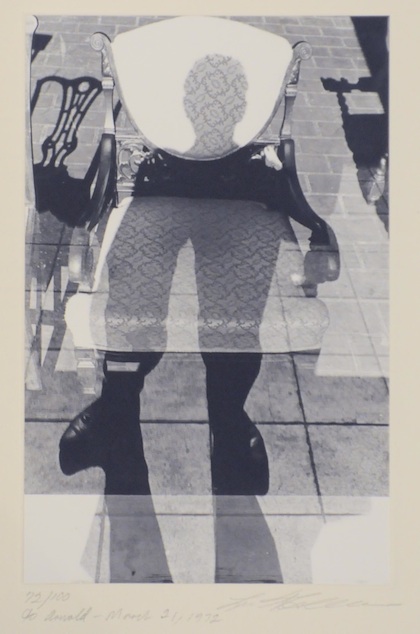
Lee Friedlander "Self Portrait" Signed Limited Edition
Limited edition of only 100 copies with an original silver gelatin print bound in and signed. Cloth binding with an additional original photograph affixed to the front board. A fine copy in black cloth boards with the print on the front board in fine condition and in a very near fine slipcase. Signed by Friedlander on the mount of the bound in photograph an additionally inscribed by him in 1972 to a minor photographer and critic. A terrific copy of what is widely considered one of the highspots of the last 50 years. ($12,500)
Offered by Jeff Hirsch Books (Booth E26)
---
.jpg)
[MAVO] SAITO Hideo, author; OKADA Tatsuo, artist. AOZAMETA DOTEIKYO. The title of this important work is usually translated as THE PALE-FACED VIRGIN'S MAD THOUGHTS. Published by Chôryusha of Tokyo in 1926. ($10,000)
Offered by the Boston Book Company (Booth C19)
---
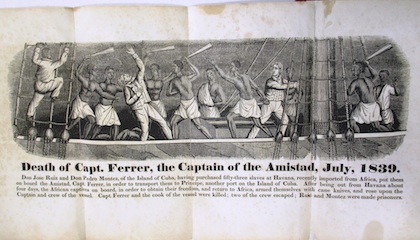
Barber, John W.: A HISTORY OF THE AMISTAD CAPTIVES: BEING A CIRCUMSTANTIAL ACCOUNT OF THE CAPTURE OF THE SPANISH SCHOONER AMISTAD, BY THE AFRICANS ON BOARD; THEIR VOYAGE, AND CAPTURE NEAR LONG ISLAND, NEW YORK; WITH BIOGRAPHICAL SKETCHES OF EACH OF THE SURVIVING AFRICANS. ALSO, AN ACCOUNT OF THE TRIALS HAD ON THEIR CASE, BEFORE THE DISTRICT AND CIRCUIT COURTS OF THE UNITED STATES, FOR THE DISTRICT OF CONNECTICUT. New Haven, CT: Published by E. L. & J.W. Barber, 1840. 32pp. Large 18-1/2 inch fold-out frontispiece ('Death of Capt. Ferrer, the Captain of The Amistad, July, 1839). Small map, and additional illustrations including 38 engraved profiles of the captives. Light foxing, Very Good. Original plain brown wrappers. Bound in modern quarter morocco, marbled boards, and gilt-lettered morocco title label on front cover.
The text of this much-sought-after foundation document on the Amistad includes illustrations of the Africans, with biographies of each; their conditions of captivity; the events of the rebellion; descriptions and customs of their homeland; the circumstances of their capture; and legal proceedings in Connecticut.
"In 1839 slaves, who had been captured in Africa, freed themselves off Cuba under the leadership of the forceful Cinque, killed all but two of the crew, and took over the Spanish ship Amistad on which they were being transported. The two spared Spaniards craftily steered the ship to New England instead of Africa. Upon landing, charges of piracy and murder were laid against the Africans, and Spain claimed them and the ship. With slave trade an explosive issue, the Amistad case became a national sensation, and Cinque a hero in the fight against slavery" (LCP Negro History Exhibition, No. 91). Aided by the advocacy of John Quincy Adams and Roger Baldwin, the U.S. Supreme Court declared them free men.
FIRST EDITION. LCP 881. Dumond 24. Sabin 3324. Not in Blockson, Work. ($17,500)
Offered by David M. Lesser Fine Antiquarian Books (Booth B10)
---

[WILSON, Bill] Alcoholics Anonymous, Works Publishing Co., 17 William St., Newark, N.J. [dated by hand: “#2 Copy / Dec. 8, 1938”]. Original front board cover + TP + 1 leaf = Index + 1 leaf = Index -- (2) + 1 leaf = Foreword + 1–4 = The Doctor’s Opinion + 1–76 + 1 leaf = The Alcoholic Foundation + 1–79 = Personal Stories. [note: with p. 64 printed upside down] + original rear board cover, 8½ “ x 11”, First Mulitlith Edition (“The Original Manuscript Edition”). ($125,000)
Offered by Athena Rare Books (Booth E41)
---
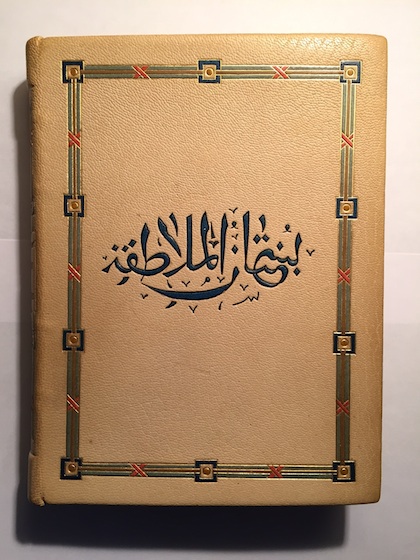
Toussaint, Franz. Le Jardin des Caresses. Paris: L’Edition d’Art H. Piazza, 1921.
Fine condition. Limited edition of only 50 copies (of which this is #44). With 10 illustrations by Leon Carré. Plates in two states, one version in black-and-white and one in color, protected by tissue guards. With a double suite of all of the color plates. Printed on Japan paper in black and blue, with decorative page borders. Octavo, 144pp. Text in French. Bound in a beautiful signed fine binding by De Samblanx- Succ. J. Behon. Cream-colored morocco tooled in gilt, blue, red, brown, and green decoration; including Arabic inscription to cover. Gilt ruling to board edges; fold-in decorated in gilt and color. With blue silk doubleurs. Original illustrated paper wraps bound in; the original cover is elaborately decorated in blue and gilt, including the Arabic inscription. Engraved bookplate to front pastedown. Housed in a custom box. A collection of poems translated from the Arabic by Franz Toussaint (1879-1955). Written in Spain by an unknown Moor in the 10th century. According to Toussaint, when the Arabs were driven out of Spain in the 15th century many scholars were attracted to Timbuctoo, an intellectual and commercial center of Islam, before the city fell into ruin. When Toussaint visited Timbuctoo, a mosque was all that remained of the famous University of Sankore, but here Toussaint met a priest who kept a few books and manuscripts that had once been part of the Sankore archives. The priest showed Toussaint an illuminated parchment of kacidas and allowed him to transcribe them—this translation became Le Jardin des Caresses. Toussaint is best know for his French translation of the Rubaiyat of Oman Khayyam. Leon Carre (1878-1942), the illustrator of the present edition of Le Jardin des Caresses, was a French orientalist painter and illustrator who spent much of his life in Algeria. ($2000)
Offered by Johanson Rare Books (Booth D6)
---
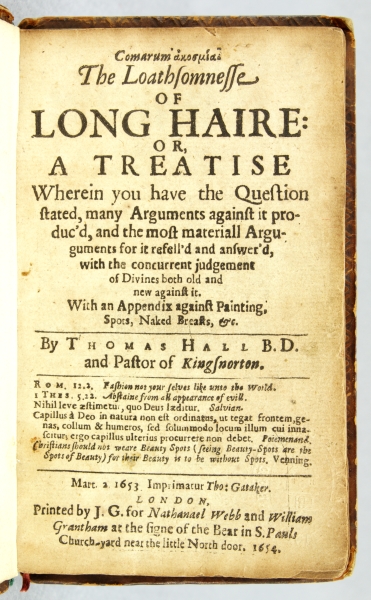
(CULTURAL HISTORY - PERSONAL FASHION, HAIR AND COSMETICS). HALL, THOMAS. COMARUM [then, in Greek:] AKOSMIA. THE LOATHSOMNESSE OF LONG HAIRE. WITH AN APPENDIX AGAINST PAINTING, SPOTS, NAKED BREASTS, &C. (London, 1654) FIRST EDITION. Recent unadorned polished calf in the style of the period.
A very rare copy of what is first and foremost a puritanical diatribe against the fashion for long hair among men, but also a work containing critical comments on the fashion crimes of women, including cosmetics ("the badge of the harlot") and brazen cleavage (an invitation to adultery). ($3,000)
Offered by Phillip J. Pirages Fine Books & Manuscripts (Booth A1).
---
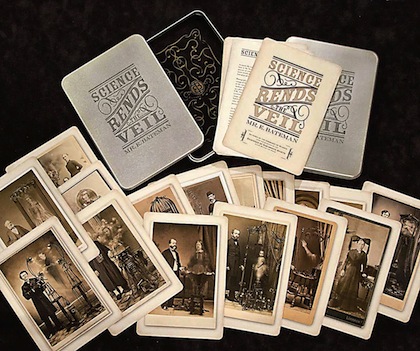
Bateman, Edward. Science Rends the Veil: An Index of the Conquest of Science over the Question of the Existence of Discarnate Spirits & Life Beyond the Grave. Salt Lake City, UT, 2014. First edition. 18 cabinet sized cards (18.5 cm x 12.5 cm) including the title card and the artist's statement card. Housed in a two piece tin with (faux) suede matte board inserts and the title etched on to the top panel. Fine.
Printed on Hahnemuhle photo rag paper 308 GM with archival pigment inks trimmed and assembled by the artistA handmade work from the Salt Lake City based artist and professor, Edward Bateman. This collection follows up on his earlier carte de visite collection 'Mechanical Brides of the Uncanny' and shows his evolving use of constructed and often anachronistic imagery to create allegedly historical artifacts that create metaphors for the camera and examine our belief in the photograph as impartial witness. ($500)
Offered by Ken Sanders Rare Books (Booth D13)
---
FRANKLIN, Benjamin (1706-1790). Poor Richard improved: being an Almanack ... For the Year of our Lord 1766 ... By Richard Saunders, Philom. Philadelphia: Printed and Sold by B. Franklin and D. Hall, [November 1765]. 12mo (7 1/4 x 4 1/4 inches). [36]pp. Woodcut illustration of an anatomical man on p. 5, 12 woodcut illustrations on the calendar pages. Stitched self-wrappers, uncut. Housed in a black chemise and black morocco backed slipcase.Provenance: Jonathan Thomas (contemporary signature in margin of p. 3) .
Rare issue of Benjamin Franklin's last Poor Richard's Almanack, including a full printing of the infamous Stamp Act.
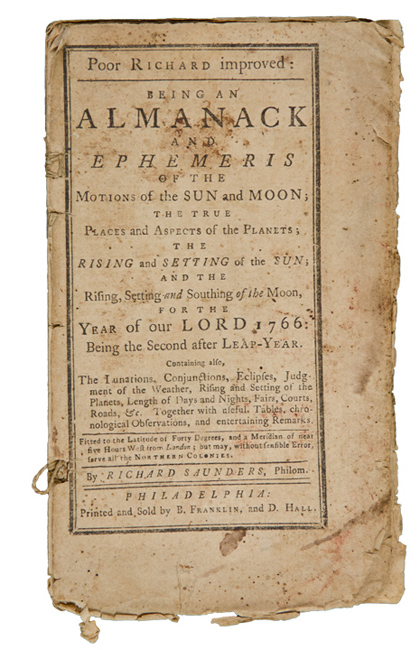
A preface, signed in print by Richard Saunders, prior to the printing of the Stamp Act reads: "As an Act of Parliament is now passed, granting and applying certain Stamp Duties in the British Colonies and Plantations in America, which takes Place the first Day of November 1765; and as that Act affects every one, almost, more or less, it is absolutely necessary that all should be acquainted with it, in order to avoide the many Forfeitures they might otherwise be liable to; I therefore thought, that I could not fill up Part of my Almanack, this Year, with any Thing of more general Use, that the Substance of that Law, in which you will see the Duties that are laid on the several Particulars, and also such Things as are exempted from paying Duty by that Act ..."
After its successful effort in the French and Indian War, the British government was saddled with a massive debt. Added to this was the cost of administering its new lands in Canada, and the necessity of protecting colonists on the American frontier from Indian attacks. In order to raise funds for border defenses, the British Parliament decided to levy a tax directly on the colonists, rather than relying on colonial legislatures to raise the funds themselves (the colonies having a notoriously spotty track record in such efforts). Over the protests of colonial agents in London, including Benjamin Franklin, a tax was levied on all legal and commercial papers, pamphlets, newspapers, almanacs, cards, and dice. A Stamp Office was created in Britain, and Stamp Inspectors were to be assigned to each colonial district. Colonists wishing to purchase or use any of the materials covered in the Act, such as the present almanac, would be required to buy a stamp. The outrage in the colonies at this form of taxation was immediate and overwhelming, and following a passionate testimony by Benjamin Franklin before Parliament, the Stamp Act was repealed in 1766. The bitterness engendered by the Act lingered on and, coupled with subsequent British laws including the Intolerable Acts and the Townshend Acts, became some of the many grievances enunciated in the Declaration of Independence.
Beyond its importance for the printing of the Stamp Act, this almanac was the last Poor Richard's Almanack to include Franklin's imprint. ($20,000)
Offered by Donald A. Heald Rare Books (Booth C1). View NY Antiquarian Book Fair catalog...
---
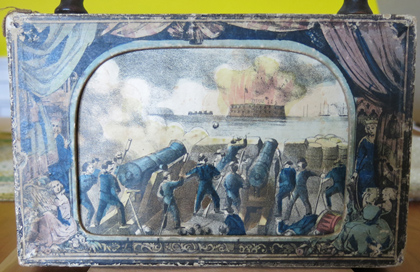
Myriopticon.... Milton Bradley & Co., n.d. but after 1865 and before 1880] Printed panorama, approx. 4 1⁄2 inches by 15 feet, mounted between two scrolls, set in cardboard frame printed in colors, representing a stage. In original 8 by 5 by 2 1⁄4 inch box, lacking cover and printing information, with replacement knobs, wear to scroll and box, repairs.
Designed to mimic the popular 19th century panoramic amusements, the Myriopticon features 22 scenes from the Civil War, beginning with the firing on Ft. Sumter and ending with the burning of Richmond. ($6500)
Offered by Kevin F. Kelly Bookseller (Booth E30).
---
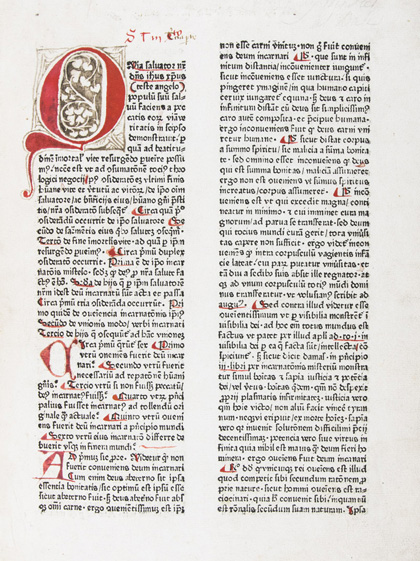
Aquinas, Thomas. Summa Theologiae Pars tertia (Third Part only) [INCUNABLE]. [Basel]: Michael Wenssler, ca 1474. First printing. Folio. Unpaginated. [272] leaves. Incunable. Original blind-stamped pigskin over wooden boards, with modern leather and brass clasps. Raised bands. Hand-painted initials in red. The Latin text, rubricated throughout, is printed double-column in handsome gothic type, with 46 lines per column, and wide margins (Hain-C. 1468; Proctor 7474; Pellechet 1057).
This is the first printed edition of this part of the "Summa". Influenced by Augustine of Hippo and Peter Lombard, The "Summa Theologiae," is the best-known work of Thomas Aquinas (c. 1225-1274). Although unfinished, the "Summa" is "one of the classics of the history of philosophy and one of the most influential works of Western literature*." It was intended as an instructional guide for moderate theologians and a compendium of all of the main theological teachings of the Catholic Church. It presents the reasoning for almost all points of Christian theology in the West. The "Summa"'s topics follow a cycle: The existence of God; Creation, Man; Man's purpose; Christ; the Sacraments; and back to God. Among non-scholars, this book is perhaps most famous for its five arguments for the existence of God known as the "five ways" (Latin: quinque viae). The "Summa" is a more structured and expanded version of Aquinas's earlier "Summa contra Gentiles," though these works were written for different purposes. Indeed, the "Summa Theologiae" explains the Christian faith to beginning theology students, and the "Summa contra Gentiles" explains the Christian faith and defends it in hostile situations, with arguments adapted to the intended circumstances of its use, each article refuting a certain belief or a specific heresy. It was while teaching at the Santa Sabina studium provinciale, that Aquinas began to compose the "Summa." He completed the Prima Pars (first part) in its entirety and circulated it in Italy before departing to take up his second regency as professor at the University of Paris (1269-1272). Our copy contains the third part (Tertia Pars) which deals with: The person and work of Christ, who is the way of man to God; The sacraments; and The end of the world. Each part contains several questions, each of which revolves around a more specific subtopic; one such question is "Of Christ's Manner of Life." Each question contains several articles phrased as interrogative statements dealing with specific issues, such as "Whether Christ should have led a life of poverty in this world?"
Tail of spine slightly chipped. Original brass ornaments and clasps removed from the binding, and replaced by two modern leather and brass clasps. Contemporary drawings and inscriptions in ink on inside of front board. Endpapers, fly leaves, as well as the margin of a few pages have been professionally repaired. Contemporary marginal manuscript annotations in black and red ink. Pages slightly rippled throughout, due to damp exposure. Clear water-staining at upper margin of a few pages (not affecting text). Small gray mold spots on lower margin between leaves 97 and 103 (not affecting text). Text in Latin. Binding in overall good, interior in good+ condition. g to g+. Hardcover.
* Ross, James F., "Thomas Aquinas, Summa theologiae (ca. 1273), Christian Wisdom Explained Philosophically", in The Classics of Western Philosophy: A Reader's Guide, (eds.) Jorge J. E. Gracia, Gregory M. Reichberg, Bernard N. Schumacher (Oxford: Blackwell Publishing, 2003), p. 165. About the printer: Michael Wenssler began printing in Basel around 1472. He was a prolific printer and is known to have produced about 150 incunabula. Around 1490, due to financial difficulties, he was forced to sell his printing equipment, and two years later he moved to France. There are about 10 incunabula known to be Wenssler's work in Cluny and Lyons. ($35,000)
Offered by Eric Chaim Kline Bookseller (Booth E31).
---
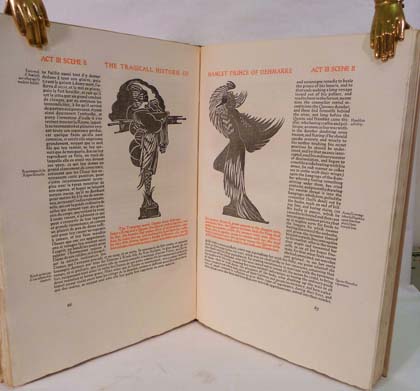
Shakespeare, William. The Tragedie Of Hamlet Prince Of Denmarke
Edited By J. Dover Wilson Litt.D. From The Text Of The Second Quarto Printed In 1604-5 `According To The True And Perfect Coppie' With Which Are Also Printed The Hamlet Stories From Saxo Grammaticus And Belleforest And English Translation Therefrom. Weimar: Cranach Press, 1923. 186 pages. Folio, 35.4 x 24.8 cm. Limited edition, copy 67 of 300 from a total edition of 322, on Maillol-Kessler hand-made paper. The English edition contains additional woodcuts by Craig not present in the German edition of 1929. Title and half-title printed from type by Eric Gill. Title and text printed in red and black, woodcut half-title illustration and 79 woodcut illustrations by and after Edward Gordon Craig, one printed in black and blue, another finished by hand in red. Back cover pocket contains J. Dover Wilson's "Notes on the Text of Shakespeare's Hamlet, 1604." THE ARTIST AND THE BOOK 66. "Together with the Maillol Virgil, this is one of the most ambitious and successful books of the Cranach Press, with a fine harmony between the type page and the illustration.....Craig worked over a period of seventeen years on the woodcuts, developing from the designs originated for his production of Hamlet at the Moscow Art Theatre in 1912." Light spotting to fore-edge tail, original dust wrapper with a few nicks, spine repaired. Orig. vellum spine lettered in gilt, light tan thick boards. Teg. Fine in rubbed original slipcase. ($25,000.00)
Offered by Roy Young Bookseller, Inc. (Booth A23)
---
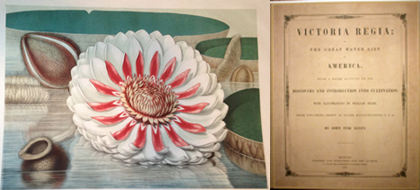
Allen, John Fisk. VICTORIA REGIA; OR THE GREAT WATER LILY OF AMERICA. With a brief account of its Discovery and Introduction into Cultivation: with Illustrations by William Sharp, from Specimens Grown at Salem, Massachusetts, USA. Boston: Printed and published for the author, 1854. A cornerstone of American color printing. These images were drawn on stone and printed by Sharp, America's first chromolithographic printer. This was the earliest example of large scale color printing in the United States. ($58,000)
Offered by The Veatchs Arts of the Book (Booth C23).
---
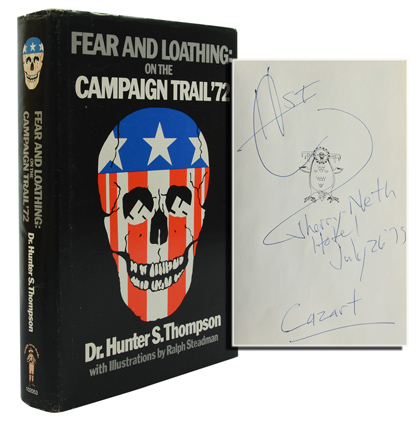
FEAR AND LOATHING ON THE CAMPAIGN TRAIL (Inscribed First Edition).
New York: Straight Arrow Books, 1973. First edition. Stated first printing on the copyright page in a first issue jacket with the white border around the photo on the rear panel. Inscribed by the author: "HST Sherry Neth Hotel July 26 '73 Cazart." The Sherry Netherland Hotel was one of the author's favorite stomping grounds while staying in New York. A wonderful early inscription, likely made while being interviewed by one of the book's first reviewers.
This copy annotated and marked by an unidentified, early reviewer. The book Very Good + on account of the annotations and minor signs of use, in a Near Fine dust jacket that is gently faded and worn at the spine, but generally bright and unrubbed. No other copy inscribed in the year of publication currently appears on the market.
A classic look at American politics focusing on the 1971 Democratic Party primary process, by the inventor of Gonzo Journalism. Illustrated by Ralph Steadman, Thompson chronicles in his inimitable style both the rise of McGovern to the nomination and the nature of political reporting itself.
“Thompson's book, with its mixed, frenetic construction, irreverent spirit and, above all, unrelenting sensitivity to the writer's own feelings while on the political road, most effectively conveys the adrenaline-soaked quest that is the American campaign.” (Contemporary New York Times Review) Very Good + in Near Fine. dust jacket. ($4,500.00)
Offered by Whitmore Rare Books, Inc. (Booth C3)
---
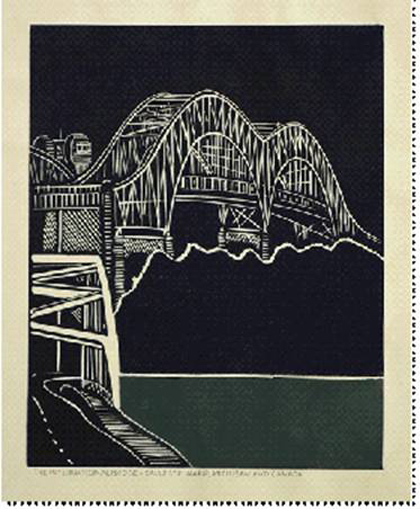
Davidson, Laura. Almost Home. Boston, MA: 2014.
Artist's book, 1 of 8 copies, all on rice paper, each signed and numbered by the artist, Laura Davidson. Page size: 9 x 7.25 inches; 6 original full-page linoleum block prints, with hand-lettered colophon page. ($2,000)
Offered by Priscilla Juvelis, Inc. (Booth A2) See more of this member's recent acquisitions in Catalog 65...
---
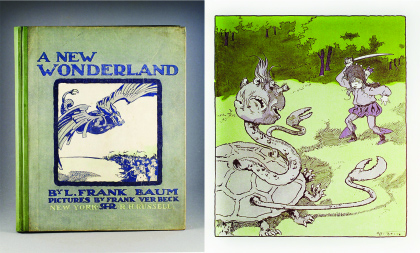
Baum, L. Frank. A New Wonderland. Illustrated by Frank Ver Beck. NewYork: Russell, 1900.
4to, x, 190pp, color frontispiece and 15 two-color plates within the pagination. Original cloth-backed pictorial boards, pictorial endpapers, a really good copy of a book rarely found in even adequate condition. In a new box.
First edition, in the first state binding with pictorial endpapers. This is Baum’s first book (although Mother Goose In Prose was published first). This title was an obvious attempt to cash in on the popularity of “Alice In Wonderland”; it was late reworked and published as “The Surprising Adventures of the Magical Monarch of Mo”. Aleph-Bet notes: “A notoriously rare Baum fantasy, that when found is usually lacking the frontis.” Not in Cotsen, Oppenheimer, Osborne, or Gumuchian.
Peter Hanff noted: “The volume has sixteen color inserts, including the title page, as follows: facing the title page, the title page, and facing pages 4, 12, 28, 38, 48, 60, 72, 92, 104, 120, 132, 152, 168, and 186. The plates, though unnumbered, are included in the pagination. Justin Schiller once had a file copy from the publisher that was annotated to indicate that the firm had run short of frontispieces.” ($6950)
Offered by John Windle, Antiquarian Bookseller (Booth D30).
---
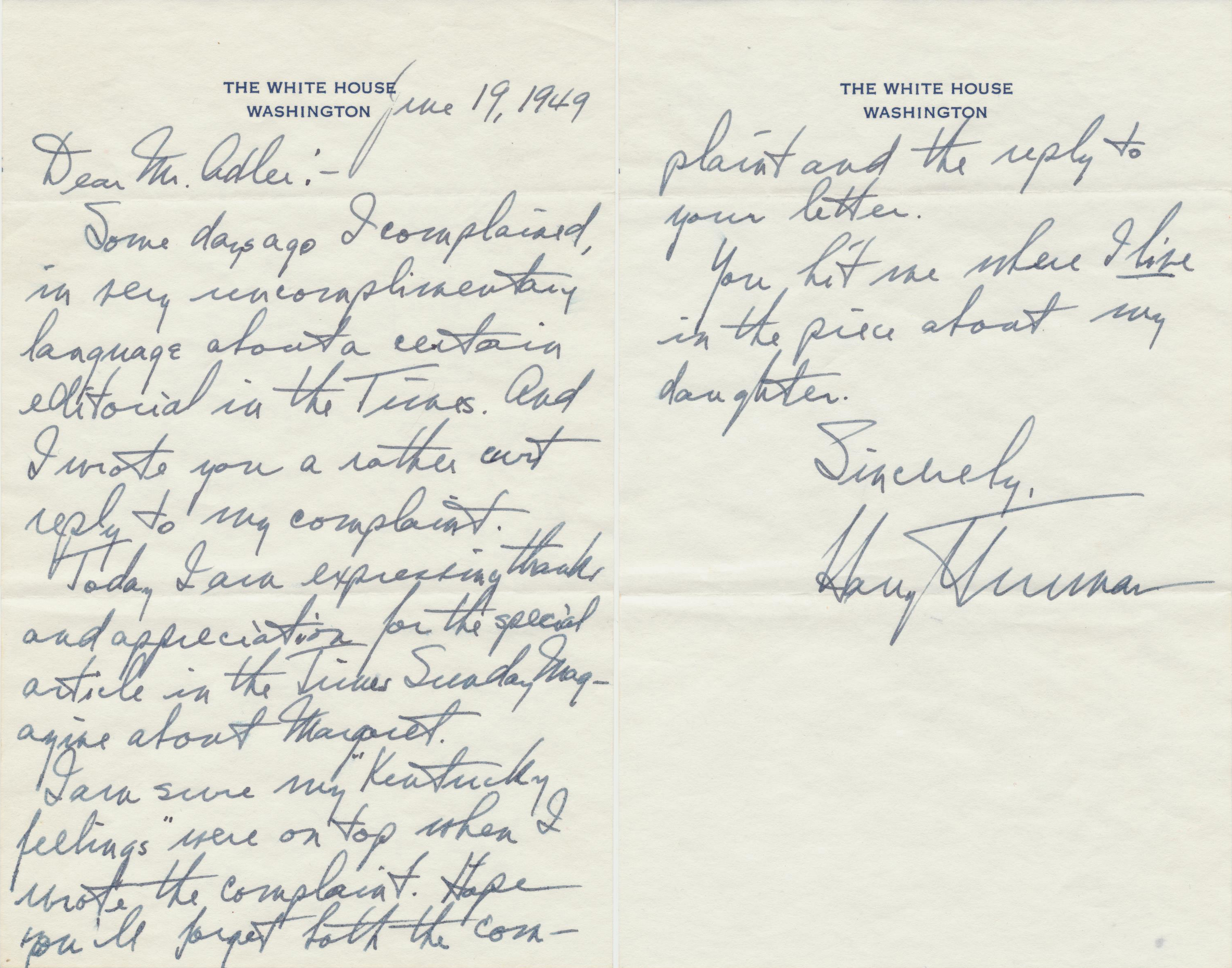
A handwritten Harry Truman letter as President to a New York Times editor, showing contrition for his earlier letter and thanking them for covering his daughter Margaret's flowering singing career. It was written a year before the most famous (or infamous) Truman letter of all, the one to The Washington Post music critic Paul Hume: http://www.trumanlibrary.org/trivia/letter.htm
Offered by Stuart Lutz Historic Documents, Inc. (Booth E28)
---
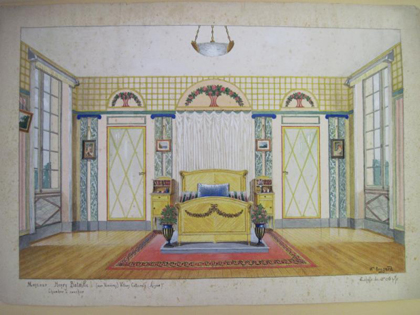
BRAGARD, Henri. Four Original Water-color Interior Designs
(Paris: circa 1895-1905.) Four original color drawings, matted. (45 x 31; 47 x 30; 47.5 x 29; and 45 x 33 centimeters).
Four finely drawn and detailed water-colors prepared by Henry Bragard, 31 Avenue d'Odeans, Paris, for Magasins du Printemps. Printemps was established in 1865, after the retail model created by Bon Marché, with large show rooms offering an array of household goods. (See Lancaster The Department Store, a Social History for more information.) Two drawings are of a study for a Pierre Laguionie (one a traditional masculine design; the other an Art Nouveau creation.) The third is of a classical drawing room; the fourth, an Art Nouveau bedroom for Henry Bataille, the French dramatist (1872-1922). ($2,850)
Offered by The Bookpress, Ltd. (Booth B22)
---
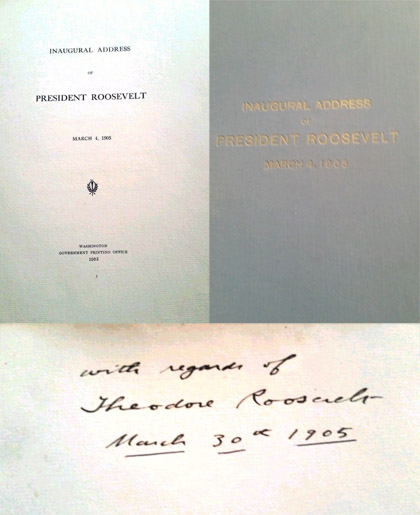
ROOSEVELT, Theodore (Teddy ROOSEVELT). INAUGURAL ADDRESS OF PRESIDENT ROOSEVELT, MARCH 4 1905. Washington DC: Government Printing Office, 1905.
First Edition. Large slim quarto (7-7/8" x 11-1/2") bound in gray cloth with gilt rules and lettering; [2], 12 pages. One of a few large-paper copies prepared for the President's personal use, this copy is SIGNED on the front endpaper: "with regards of/Theodore Roosevelt/March 30th 1905." Exceptionally scarce we could locate only the following copy, sold at auction by Doyle in 2014. This from their description: "The Inaugural Address for Theodore Roosevelt's second presidential term in its large-paper form; when R. W. G. Vail, the one-time Librarian of the Roosevelt House (and later of the American Antiquarian Society) catalogued the copy in the Roosevelt collection at Harvard, he described it as a rarity. That copy was not signed. We can locate no copies at auction, inscribed or otherwise, and have located one signed copy institutionally, at the William Clements Library at University of Michigan. As Roosevelt became president upon the assassination of William McKinley, there was just a swearing-in, but no inauguration before his first term, so this was Roosevelt's first inauguration." Walter R. Benjamin Autographs in 1997 described the Doyle copy as "Arguably one of the most extraordinary inaugural items ever on the market place." Some foxing to the endpapers with no effect on the signature; some fading to the fore-edge of the front cover and light soiling to the rear. Near Fine and an exceptional item. ($15,000)
Offered by Charles Agvent (Booth D27).
---
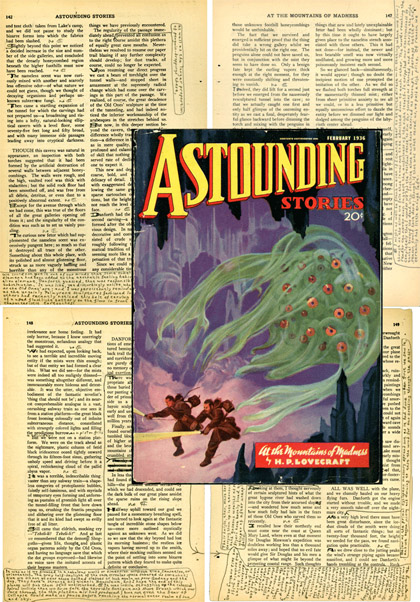
Lovecraft, H[oward] P[hillips]. "AT THE MOUNTAINS OF MADNESS." A complete set of tear sheets of the first appearance of this short novel; serialized in three issues of ASTOUNDING STORIES, February, March, and April 1936, pp. 24-32; 125-155; 131-150. Copy-edited with extensive handwritten revisions in pencil by Lovecraft. ($25,000)
First edition. The revisions are of three types: (1) restoring many of the paragraphs to the longer length of the original manuscript; (2) minor corrections of spelling or punctuation and changes or insertions of just a few words; (3) insertions of major blocks of copy that were cut from the original text. Revisions of the first type were indicated by Lovecraft's enlarging the first capital letter of the added-on paragraph so that it was flush left instead of indented, and, when space permitted, by writing a pilcrow at the end of the preceding paragraph. The tear sheets have a total of 352 of these changes. Changes of the second type add up to 51. Changes of the third type are found mostly in the third installment, with none in the first and just one in the second installment, but thirteen in the last. These restorations of text cut by ASTOUNDING's editor, F. Orlin Tremayne ("that god-damn'd dung of a hyaena," as Lovecraft described him in a letter to R. H. Barlow), add up to over a thousand words. They are printed in small but neat script in the margins.
This is one of three known sets of corrected tear sheets, all of which made their way (presumably through HPL's literary executor, R. H. Barlow) to August Derleth at Arkham House, where they provided the "revised" text for its appearance in THE OUTSIDER (1939). The story was written in 1931, submitted to and rejected by WEIRD TALES editor Farnsworth Wright for being "too long, not easily divisible into parts, not convincing -- & so on" (letter to S. Vernon Shea, 7 August 1931, Selected Letters, III, #487). In the same letter, Lovecraft goes on to remark, "Life has never interested me as much as the escape from life. However -- there is a region on the border betwixt weirdness & scientifiction in which I might conceivably experiment. Indeed, the Mountains of Madness belongs largely to this type." In several subsequent letters he referred to the novella as "my best story" or "my most ambitious story" and was considerably discouraged by its rejection. In writing to E. Hoffmann Price (9 April 1934, Selected Letters IV, #697) he referred to it as "a novelette representing my most serious endeavor -- Antarctic archaeology and polar mystery of a type that has haunted me since I was 11 years old. Its rejection by Wright in 1931 was a psychological setback doing much to freeze me into silence." In another letter written later that year to Price, however, he mused that this hiatus might have been beneficial in forcing him to detect and root out certain bad habits in his work. Lovecraft made no further efforts to sell the story but in 1935 Julius Schwartz, acting as his agent, took MOUNTAINS and THE SHADOW OUT OF TIME to ASTOUNDING's editor, Tremaine, who bought the pair, unread, for $595. The money came at a time when Lovecraft was perilously close to poverty but when he saw the tear sheets he was furious at the edits made by Tremaine. The damage to the text was not completely repaired until the discovery of a fair-copy typescript of the story years later. There is no known copy of a holograph version of this text, making the sets of hand-edited tear sheets the closest approximation to such a thing.
"At the Mountains of Madness" presents what is probably the most complete and compelling vision of Lovecraft's cosmology, encompassing the Old Ones (extraterrestrial aliens who arrived on Earth millions of years ago and built vast, but now ruined, cities), the shoggoths (hypnotically controlled protoplasmic blobs who served them as unwilling slaves), the fungi from Yuggoth and spawn of Cthulhu (other aliens who arrived later and battled the Old Ones, driving them back to their first settlement in the Antarctic. The cosmology gradually unfolds in the course of an adventure story about a team of explorers visiting the Antarctic and encountering a gigantic mountain, taller than Everest, in the interior of which they discover relics of the Old Ones's civilization -- and confront a thawed-out shoggoth, turned monstrous without the hypnotic control of the Old Ones, who are all dead. The Antarctic setting has prompted some critics to compare Lovecraft's novella to Poe's NARRATIVE OF A. GORDON PYM, but they share little except the overall setting: a blank white canvas onto which could be conveniently painted whatever horrors the author chose. This short novel is one of the twenty-two tales selected for the Library of America's 2005 edition of Lovecraft's fiction. The tear sheets are in generally fine condition and are accompanied by the front and rear covers of the first of the three issues of ASTOUNDING in which the story appeared.
Offered by John W. Knott, Jr. Bookseller (Booth D9).
---
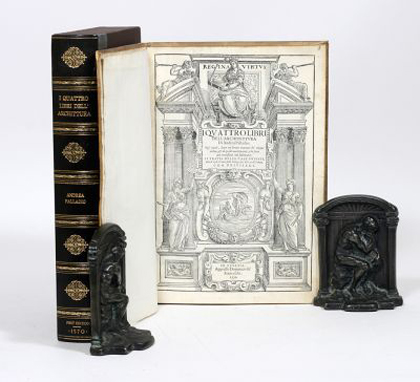
PALLADIO, ANDREA. I Quattro Libri dell'Architettura (The Four Books of Architecture)
First edition of arguably the most influential architectural book in the Western World, with over 200 woodcut illustrations. PMM 92.
"Palladio's lasting influence on architectural style in many parts of the world was exercised less through his actual buildings than through his textbook. This is divided into four sections: orders and elementary problems, domestic building, public building and town planning and temples. Palladio's style was directly inspired by Roman classical models through the writings of Vitruvius and Alberti. Its characteristics are those of classicism: symmetry, order, fixed mathematical relations of the parts to each other and to the whole, logic and monumentality… In spite of the vogue for the baroque and the fact that Palladio left no immediate successors, his book exerted a powerful influence on contemporary architecture and classical ideals until the end of the eighteenth century. In England… ’Palladianism’ became a party label in the world of connoisseurship and England blossomed with buildings ‘in the Palladian style’—two centuries after Palladio had created it. From England the style made its way into Scotland, Ireland and America" (Printing and the Mind of Man 92).
"The Quattro Libri exerted an astonishing impact on the architects and architecture of the centuries following its publication, and helped make Palladio the most imitated architect of all time" (Wiebenson, Architectural theory and Practice). Palladio's neo-Renaissance followers include Inigo Jones, Christopher Wren, and Thomas Jefferson. In fact, Jefferson's designs for his Monticello estate and the University of Virginia were based on Palladio's Four Books, which Jefferson referred to as his "Bible".
Venice: Domenico de'Franceschi, 1570. Folio, early (possibly contemporary) Italian vellum. Expert (and likely early) unobtrusive reinforcement to the hinges of the versos of the first two leaves. Two tiny wormholes to first few leaves; a few spots of dampstaining in the first few gatherings; otherwise text exceptionally clean and crisp with unusually wide margins. An outstanding copy in beautiful early Italian vellum. ($100,000
Offered by The Manhattan Rare Book Company (Booth A28).
---
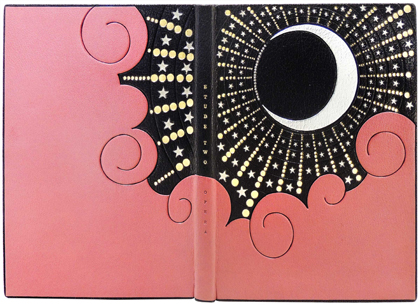
Wu, Robert, Etude Two. Opera.
Toronto: Robert Wu, 2007. Unique blank journal in fine full leather designer binding by Canadian binder Robert Wu, signed and dated on bottom edge on interior of rear cover. This stunning piece featuring an elaborately gilded night sky was created was as a "study book" for the artist to practice his techniques. Bound in black and pink morocco with onlayed silver crescent moon, pink clouds, silver stars, and gilt circles of light. Red and black marbled paper pastedowns with black morocco doubles facing yellow leather endpages, both tooled in metallic pastels. The edges of the textblock have been fully colored in pink (to match the clouds on the covers), speckled, and tooled. Handsewn headbands in matching pastel stripes. Housed in a marbled paper covered slipcase with chemise. The chemise is covered in green marbled paper with a black and pink morocco spine titled in gilt, which matches the binding of the journal. The interior of the chemise is lined in bright green suede. Unpaginated. Fine. ($3,600)
Offered by The Kelmsott Bookshop (Booth E27).
---
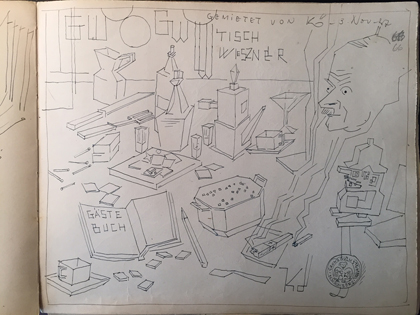
1921-1935 Weimar Guest Book, Owned by Georg Wieszner & Lily Wieszner of Nuremberg
With Original Art, Poetry, Music & Collages by Weimar Artists
Nuremberg manuscript guest book signed by and with original drawings, poetry, woodblock prints, photographs, sketches, music, watercolors and comments by numerous artists, politicians and writers of the time. The guest book, approximately 100 leaves, begins in 1921-22 (New Year’s Eve - Sylvester) and ends ominously in 1935. It belonged to Georg Gustave Wieszner (1893-1969) and his wife Lily Wieszner (born 1894 in Nuremberg), both of whom were active in the intellectual and artistic life during the Weimar period.
Some of the contributors to the book are as follows:
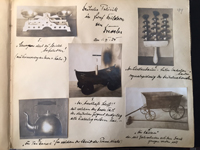 Max Adler, jurist
Max Adler, jurist
Hedda Berger, film actress
Hans Bloesch, publisher
Julius Fleischmann, Nuremberg City Official
Wassily Kandinsky, artist
Nina Kandinsky, wife of the artist
Karl Vossler, linguist, scholar
Wilhelm Nida-Rumelin, sculptor
Hans Johst, dramatist (Nazi Poet Laureate)
Lilly Klandy, Film actress
Eugen Ortner, journalist
Hanns John, Cantor
Max Martersteig, actor, writer
Gerald Hamilton, spy/traitor
Max Liebermann, artist
Max Ohmayer, painter
Oskar Schlemmer, artist, thespian
There are approximately 300 signatures - most with comments on the times, drawings, poetry, and music; one of the most compelling efforts is a full page color painting of a scene for the play “Don Gil Von Den Grunen Hosen” by Walter Braunfels, a signer of the guest book. The painting is signed with the monogram of an S and K in a circle or O, strongly suggestive of the name Oskar, as in Schlemmer. And, on the opposing page in German is written “reproduction forbidden,” with, again, the same monogram. It is also possible that Kandinsky saw the scene painting of “Den Grunen Hosen,” which features something like dark green stage smoke in much of the center. Two days after signing the guest book, on his birthday, Dec. 16, he painted his work “Too Green” which he gave to Paul Klee for his 50th birthday. (The signature above his appears to be “O. Schlemmer”).
In general, this Weimar Guest book gives testament to the highly productive and exuberant Art Deco – Bauhaus period in Germany during the 1920s. As attitudes began to change towards the end of the twenties and the early thirties, many contributing artists took note of “something bad in the soup” and left Germany, while other contributors welcomed and joined the Nazi party. ($26,000)
Offered by Johanson Rare Books (Booth D6).
---
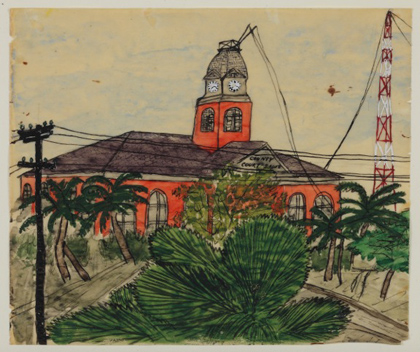
BISHOP, Elizabeth. County Courthouse. An original watercolor, gouache and India ink on paper by Bishop, 6 ¾” wide x 5 ¾” high, circa 1938. Benton 23. For three months during the winter of 1938, Bishop lived in a boarding house at 529 Whitehead Street, across the street from the Monroe County Courthouse, a two-story red brick courthouse built in 1890. In all probability this picture represents the view from the boarding house. The courthouse survives, and still appears almost unapproachably tangled up in a welter of trees, telephone poles and electrical wires. ($25,000)
Offered by James S. Jaffe Rare Books (Booth A22).
---
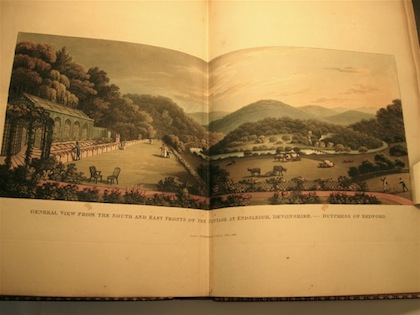
Repton, Humphry, assisted by his son John Adey Repton. FRAGMENTS ON THE THEORY AND PRACTICE OF LANDSCAPE GARDENING, Including Some Remarks on Grecian and Gothic Architecture, Collected from Various Manuscripts, in the Possession of the Different Noblemen and Gentlemen for Whose Use They Were Originally Written; the Whole Tending to Establish Fixed Principles in the Respective Arts. London: Printed by T, Bensley and Son for J. Taylor, 1816. 4to (13 5/8 x 11 inches). xii, 238, (1) pp. 20 hand-colored plates, 11 with overslips, three double-page; 18 tinted or uncolored plates, three with overslips; 11 vignettes, two with overslips; five maps and plans, one hand-colored or partly hand-colored.
Half-title; "List of Plates" leaf, including errata. Recent scarlet straight-grained morocco, with elaborate gilt rolls and ornaments framing the boards, gilt inner dentelles, spine richly gilt between raised bands, gilt spine title, a.e.g. (original), by Phil Dusel.
Several overslips professionally repaired, scattered light foxing, else a beautiful wide-margined copy in a new binding done in period style, artfully accomplished.
First edition of Repton's final work on landscape gardening, written together with his son. Inscribed on the front endpaper "From Mr & Mrs Flower to Their Friends Mr & Mrs J. Warder As a Token of grateful Remembrance For their kind Attention To Themselves and Family June 18, 1818." The manuscripts used and referred to on the title page were the author's own notebooks, known as his "Red Books," with descriptive proposals and illustrations for the improvement of more than 200 estates." Abbey Scenery 391. Tooley 398. ($25,000)
Offered by Bartleby's Books (Booth B12)
---
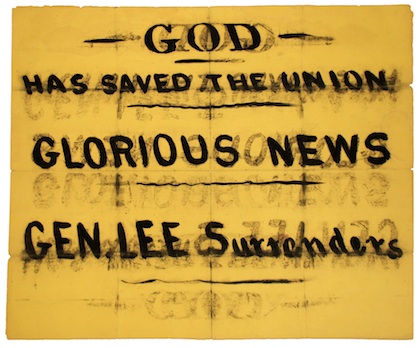
Union Victory Divinely Ordained, Says Broadside: “God Has Saved the Union - Glorious News - Gen. Lee Surrenders”
On the afternoon of April 9, 1865, Robert E. Lee surrendered to U.S. Grant at Appomattox, effectively ending the Civil War. This hand-lettered broadside relays the exciting news as it spread across the nation. The immediacy of its hand-lettering is apparent and dramatic, and a contemporary manuscript note on the verso provides details of how it was displayed in a Newburgh, New York, newsstand as news of the long-awaited victory was received.
[CIVIL WAR]. Broadside. Hand-lettered. “God Has Saved the Union. Glorious News. Gen. Lee Surrenders.” [Newburgh, N.Y., April 10, 1865]. 1 p., 30 x 241Ž2 in. In bold black lettering, ghosting from contemporary folding. ($6,800)
Manuscript note on verso: “This Bulletin was displayed by Solomon & Co, Newsdealers, Cor Water & Second Sts at Newburgh, Orange Co, N.Y. on Monday, Apr 10th 1865. C.H. King, Newburgh, N.Y. Apr 12th 1865.”
Offered by Seth Kaller, Inc. (Booth E14)
---
More information about the 55th annual New York Antiquarian Books Fair can be found here...


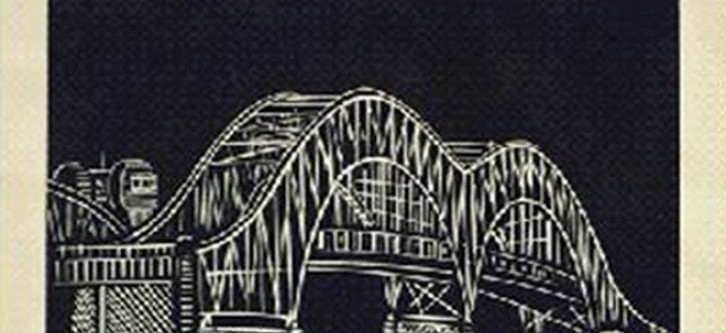



.jpg)



















 Max Adler, jurist
Max Adler, jurist

